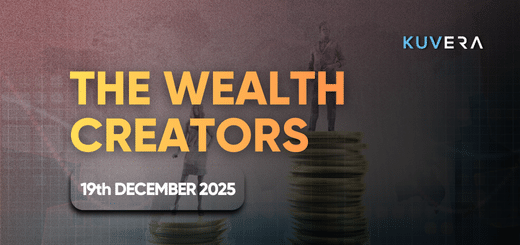In this edition, we talk about the positive changes in offing in India’s health insurance market. We also explain why S&P Global’s decision to improve its outlook on India matters and how the Reserve Bank of India has cracked down on “evergreening” of bad loans. We then finish it off with the raging hot weather and some chess talk.
Welcome to Kuvera’s weekly digest on the most critical developments related to business, finance, and the markets.
tl;dr Hear the article in brief instead?

“It is health that is real wealth and not pieces of gold and silver,” Mahatma Gandhi said once upon a time.
Gandhi was in news this week, for reasons well beyond the scope of this newsletter. But his comment on health being the real wealth is, indeed, of critical interest to all of us. And this week brought some good news on this front with India’s insurance regulator issuing several directions to health insurers to make life a little easier for people.
The Insurance Regulatory and Development Authority of India, or IRDAI, asked health insurance companies to approve the final cashless authorization at the time of discharging a patient within three hours of receiving the bills. In case of a delay, the insurers will have to shell out the additional amount charged by the hospital, the IRDAI said.
The IRDAI also asked health insurers to offer policyholders an option to either select higher sum insured or a discount on renewal premium in the event there is no claim on a policy in a given year.
Policyholders will also be able to cancel their insurance policies any time after issuing a seven-day notice to the insurer in case they are not satisfied or find a better deal elsewhere. In addition, the regulator prescribed higher penalties for insurance companies if they don’t comply with orders of the insurance ombudsman within 30 days.
These directions will definitely help policyholders breathe a little better when dealing with healthcare issues of their own or their family members, especially at a time when hospital bills are going through the roof.
So, if you are an existing policyholder, be aware of these additional facilities that the insurance regulator has just granted. And if you don’t already have a health insurance policy, go get one right now and stay healthy!
From S&P with love

Moving on from individual health to the health of the economy, India has finally received a glowing report card from S&P Global Ratings after a decade. The ratings firm raised the outlook on India to positive from stable on May 29.
To be sure, S&P continues to rate India at BBB-, which is the lowest investment-grade sovereign credit rating. This is in line with the assessment of the other two global rating agencies, Moody’s Ratings (Baa3) and Fitch Ratings (BBB-).
However, unlike Moody’s and Fitch, S&P now has a positive outlook on India.
“Our positive outlook on India is predicated on its robust economic growth, pronounced improvement in the quality of government spending, and political commitment to fiscal consolidation,” S&P said as it praised the economy’s “remarkable comeback” from the COVID-19 pandemic and forecast a GDP growth rate of close to 7% over the next three years.
But perhaps the most important part of S&P’s commentary was a non-action: continued policy stability, deepening economic reforms, high infrastructure investment, and reduction in the government’s debt burden “could lead to a higher rating over the next 24 months”, it said.
The outlook upgrade from S&P and the prospect of an actual rating upgrade is a win for the Indian government in more than one way. The first is the praise amid a raucous election season, with S&P saying Prime Minister Narendra Modi’s administration “has increasingly shifted budget allocation to infrastructure spending”.
The second win is one that must be seen in a broader context and longer time scale.
For years now, the Modi government has been waging a war with S&P, Moody’s, and Fitch as it thinks that the lowest investment grade rating that has been assigned to India is not a true reflection of the economy’s underlying strength. Such has been the extent of the government’s indignation that the finance ministry’s Economic Survey for 2020-21, released a day before the Union Budget for 2021-22 was presented in Parliament, contained an entire chapter titled ‘Does India’s Sovereign Credit Rating reflect its fundamentals? No!’.
Why does the country’s credit rating matter so much?
The rating indicates a country’s creditworthiness – the higher, the better. A better rating allows a country to borrow money at a lower cost – or rate of interest – as it is deemed to be a more secure loan. This is one of the reasons why the yield on the 10-year US government bond is 4.55%, while that on the Indian counterpart is 7.05%.
For rating agencies, the bottomline has seemingly always been about India’s public debt levels. Even before the pandemic, during which the combined debt of the central and state governments crossed 90% of India’s GDP, the three agencies had been voicing their concerns about the state of government finances.
The sand seems to be shifting now. S&P expects the government’s debt-to-GDP ratio to decline to 81% in the next few years aided by the rapid economic growth and sharper-than-expected cuts in the annual fiscal deficits.
All-action RBI
It has been a busy 2024 for the Reserve Bank of India and the central bank is not stopping anytime soon to take a breather.
After effectively ordering Paytm Payments Bank to wind down its operations in late January, the RBI in March barred IIFL Finance from giving out gold loans and JM Financial from giving loans against shares and debentures. This week, it told ECL Finance Ltd and Edelweiss Asset Reconstruction Company Limited – both Edelweiss Group companies – to stop certain types of transactions.
According to the RBI, the two companies acted together to ‘evergreen’ stressed exposures of ECL Finance. Security receipts were valued incorrectly by both the companies, with ECL Finance violating multiple norms include those relating to loan-to-value for lending against shares and incorrect reporting.
To top it all, the RBI said that “instead of taking meaningful remedial action”, the entities resorted to new ways to “circumvent regulations”. And as was the case with Paytm Payments Bank and others, behind-the-scenes conversations between the RBI and senior management of the two companies did not result in any “meaningful corrective action”. This forced the RBI’s hand.
The central bank has had to make some big – and tough – decisions against companies from the financial sector in the last year or so. But if the sector as a whole is healthy – S&P noted on May 20 that it believed that the balance sheets of India’s corporate and financial sectors were now stronger than before the pandemic – then such business restrictions for some entities is a small price to pay.
Hot, hot, hot!

Indian weather conditions, just like the economy, are running red hot at the moment.
On May 29, the capital city of New Delhi posted a record high temperature of more than 52 degrees Celsius. And while the India Meteorological Department thinks there might have been an error in the reading, there is no denying how awfully hot it is with a court in the capital even refusing to hear a case and adjourning it to November on account of the sweltering conditions and malfunctioning air-conditioners.
ACs, though, seem to be working overtime. On May 31, Delhi Chief Minister Arvind Kejriwal said the peak power demand of 8,302MW this year had exceeded last year’s maximum by 12%. And while the absence of power cuts has brought some relief to the citizens of Delhi, they are having to deal with water shortage instead. The local government has now approached the Supreme Court with a demand for increased supply of water from Himachal Pradesh, Haryana, and Uttar Pradesh.
But there is a silver lining to this, erm, dark cloud.
On May 30, the meteorological department said the monsoons had hit coastal Kerala two days earlier than expected. The southwest monsoon is crucial to India for multiple reasons: one, to alleviate the heat, and two, to irrigate the farms and ensure sufficient agricultural production and stable food prices. Above-average rains this year then, as the IMD has predicted, will not only cool the nerves but also consumer inflation.
Chess sorcerers
It has been a watershed year for Indian chess, with a handful of teenagers making it a habit to upstage their older and higher-ranked opponents in global events. The latest such takedown was performed by Rameshbabu Praggnanandhaa – or Pragg, as he is fondly called around the world – who defeated world number one Magnus Carlsen on May 29 at the five-time world champion’s home event, Norway Chess, in the city of Stavanger.
What is worth highlighting about Pragg’s victory over Carlsen is that it was his first such win in the so-called ‘classical’ format of the game – over-the-board chess, not online, and no pieces falling as players rush to make moves in their fight against the clock. Further, the stage could not have been much bigger: the event is one of the strongest tournaments in the world.
But will Pragg’s victory over Carlsen be the trailer to the film that is the World Chess Championship?
Later this year in November, world champion Ding Liren of China will look to stave off India’s teenage sensation Dommaraju Gukesh. It was only in April that Gukesh, 17 years old at the time, famously won the right to challenge Liren for the world title. Having just turned 18 – incidentally on the same day as Pragg beat Carlsen – Gukesh is only a few months away from battling it out at the pinnacle of the sport. And he could have home advantage too, with India attempting to host the World Chess Championship. That would be one way to end the year!
Market Wrap
India’s stock markets had managed to end in the green last week and touched new record highs this week, but eventually lost ground due mainly to uncertainties related to the outcome of the Lok Sabha elections. The last phase of the polls will be held on June 1 with results due on June 4.
The 30-Sensex touched an all-time high of 76,009.68 on Monday while the 50-scrip Nifty hit 23,110.80. For the week, the Sensex ended almost 2% down while the Nifty fell 1.85%.
Only one in five Nifty stocks closed in the green this week. Drugmaker Divi’s Labs led the winners, gaining more than 4%. Adani Ports rose after news it will replace Wipro in BSE’s 30-stock Sensex. Hindalco, Bajaj Auto, IndusInd Bank, Larsen & Toubro and HDFC Bank were among the others that ended higher.
Nifty stocks that ended in the red were led by Tech Mahindra, which lost nearly 7%. Wipro, TCS and Infosys were among the other tech stocks that slipped. State-run companies ONGC, NTPC and BPCL fell, too. Grasim, Titan, Maruti Suzuki, Nestle, Bajaj Finserv and Tata Steel were among the other big losers this week.
Other Headlines
- RBI net income surges 141% in FY24 to Rs 2.11 trillion ($25.3 billion) on the back of lower provisions
- Apollo Hospitals Q4 consolidated net profit jumps 76% to Rs 254 crore but misses estimates
- India’s pharmaceutical exports to grow nearly 11% in FY25 to cross $31 billion, says Pharmexcil
- Tata Steel Q4 profit falls 64% to Rs 611 crore on lower prices amid restructuring
- LIC posts 2.5% rise in Q4 profit to Rs 13,763 crore
- Space startup Agnikul launches Agnibaan, India’s second privately built rocket
- India’s silver imports at 4,172 metric tons in January-April 2024, surpassing the total for all of 2023
- Adani Total plans to build more plants in India for LNG import
- Buzz around Adani Group investing in Paytm but both issue denials
- Adani Enterprises to raise up to Rs 16,600 crore; Adani Energy Solutions to raise Rs 12,500 crore
- Google, Amazon, Apple lobby group opposes India’s EU-like competition law
That’s it for this week! Until next week, happy investing!
Interested in how we think about the markets?
Read more: Zen And The Art Of Investing
Watch here: Understanding Index Funds from experts
Start investing through a platform that brings goal planning and investing to your fingertips. Visit kuvera.in to discover Direct Plans and Fixed Deposits and start investing today.












